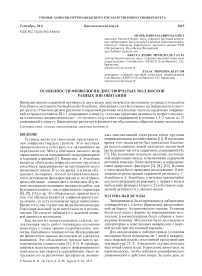Особенности физиологии двустворчатых моллюсков разных зон обитания
Автор: Бахмет Игорь Николевич, Де Сауза Абесса Денис Моледо, Буруэм Лукас Морейра
Журнал: Ученые записки Петрозаводского государственного университета @uchzap-petrsu
Рубрика: Биология
Статья в выпуске: 6 (151), 2015 года.
Бесплатный доступ
Проведен анализ сердечной активности двух видов двустворчатых моллюсков: устрицы Crossastrea brasiliana и моллюска Anomalocardia brasiliana, обитающих соответственно на поверхности и внутри грунта. Отмечено резкое различие в сердечной ритмике моллюсков: частота сердечных сокращений устрицы составила 28 ± 1 сокращение в минуту, тогда как сердечная активность второго моллюска отличалась апериодичностью - от полного отсутствия сокращений в течение 1,5-2 часов до 12 сокращений в минуту. Выявленные различия в физиологии обусловлены образом жизни моллюсков.
Устрица, аномалокардиа, сердечная активность
Короткий адрес: https://sciup.org/14750956
IDR: 14750956
Список литературы Особенности физиологии двустворчатых моллюсков разных зон обитания
- Жирков И. А. Жизнь на дне. Био-экология и био-география бентоса. М.: МГУ, 2010. 453 с.
- Bakhmet I. N., Berger V. Ja., Khalaman V. V. The effect of salinity change on the heart rate of Mytilus edulis specimens from different ecological zones. J. Exp. Mar. Biol. Ecol. 2005. Vol. 318 (2). Р. 121-126.
- Begum S., Basova L., Strahl J., Sukhotin A., Heilmayer O., Philipp E., Brey T., Abele D. A metabolic model for the ocean quahog Arctica islandica -effects of animal mass and age, temperature, salinity, and geography on respiration rate. J. Shellf. Res. 2009. Vol. 28 (3). P. 533-539.
- Depledge M. H., Andersen B. B. A computer-aided physiological monitoring system for continuous, long-term recording of cardiac activity in selected invertebrates. Comp. Biochem. Physiol. 1990. № 96. Р. 474-477.
- Depledge M. H., Amaral-Mendes J. J., Daniel B., Halbrook R. S., Kloepper-Sams P., Moore M. N., Peaka 11 D. B. The conceptual basis of the biomarker approach. D. B. Peakall and L.R. Shugart (eds.) Biomarkers: Research and application in the assessment of the environmental health. NATO ASI Series H: Cell Biology. 1992. Vol. 86. P. 15-29.
- Lannig G., Flores J. F., Sokolova I. M. Temperature-dependent stress response in oysters, Crassostrea virginica: pollution reduces temperature tolerance in oysters. Aquat Toxicol. 2006. Vol. 79. P. 278-287.
- Marshall D. J., McQuaid C. D. Differential physiological and behavioural responses of the intertidal mussels, Choromytilus meridionalis (Kr.) and Pernaperna L., to exposure to hypoxia and air: a basis for spatial separation. J. Exp. Mar. Biol. Ecol. 1993. Vol. 171 (2). P. 225-237.
- Marshall D. J., McQuaid C. D. Seasonal and diel variations of in situ heart rate of the intertidal limpet Siphonaria oculus Kr. (Pulmonata). J. Exp. Mar. Biol. Ecol. 1994. Vol. 179 (1). P. 1-9.
- Narchi W. Comparative study of the functional morphology of Anomalocardia brasiliana (Gmelin, 1791) and Tivela mactroides (Born, 1778) (Bivalvia, Veneridae). Bull. Mar. Sci. 1972. Vol. 22 (3). P. 643-670.
- Santini G., Williams G. A., Chelazzi G. Assessment of factors affecting heart rate of the limpet Patella vulgata on the natural shore. Mar. Biol. 2000. Vol. 137 (2). P. 291-296.
- Segal E. Acclimation in mollusks. Amer. Zoologist. 1961. Vol. 1 (2). P. 235-244.
- Taylor A. C. Burrowing behaviour and anaerobiosis in the bivalve Arctica islandica (L.). J. Mar. Biol. Assoc. UK. 1976. Vol. 56. P. 95-109.
- Taylor L. N., Mc Ge e r J. C., Wood C. M., McDonald D. G. Physiological effects of chronic cooper exposure to rainbow trout (Oncorhynchus mykiss) in hard and soft water: evaluation of chronic indicators. Environ. Toxicol. Chem. 2000. Vol. 19. P. 2298-2308.
- Yamagishi H., Uesaka H., Ebara A. Phase-response analysis of stretch-mediated beat coordination in the oyster heart. II. Mutual entrainment of auricle and ventricle. Zool. Sci. 1995. Vol. 12. P. 405-409.


